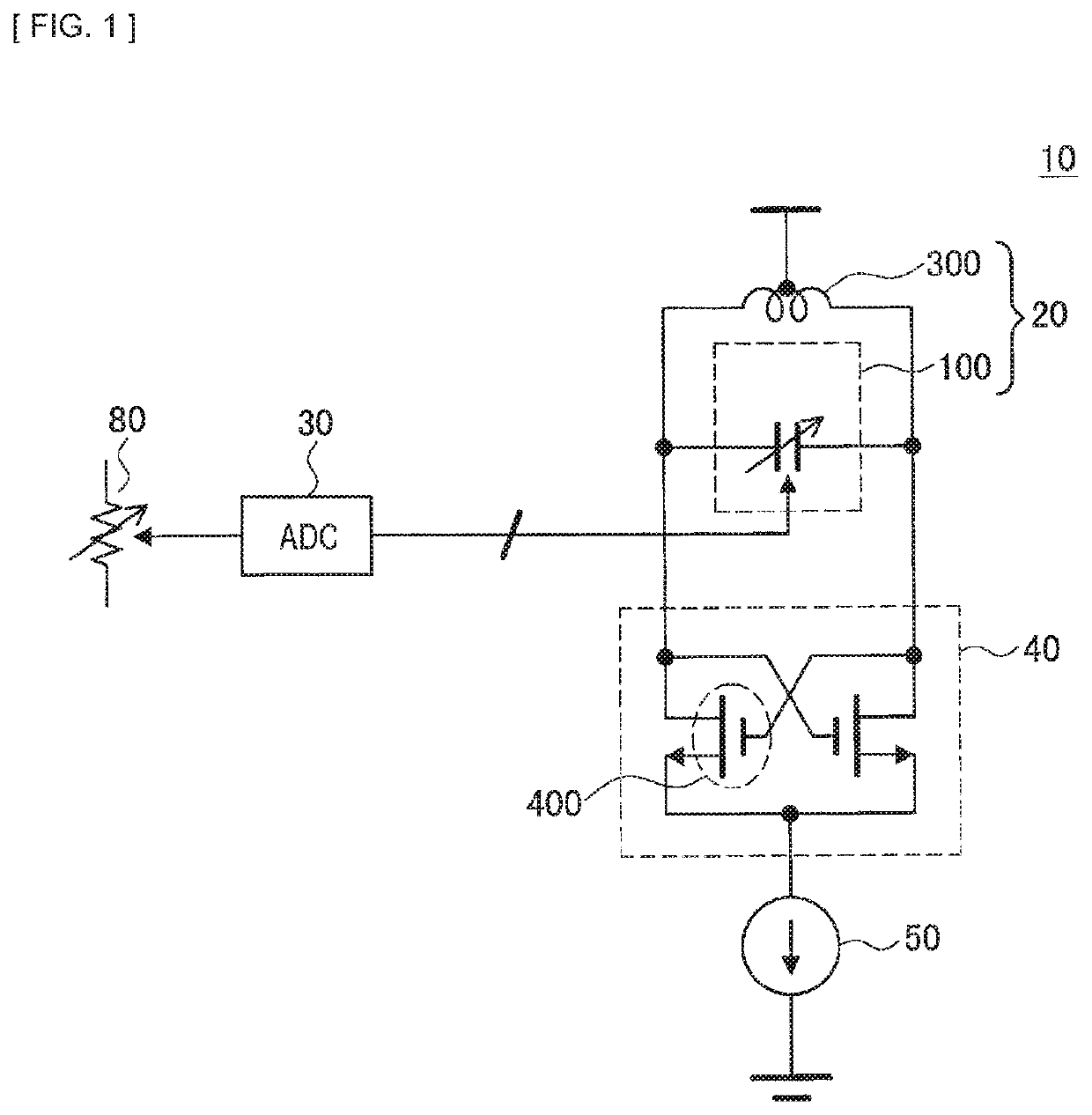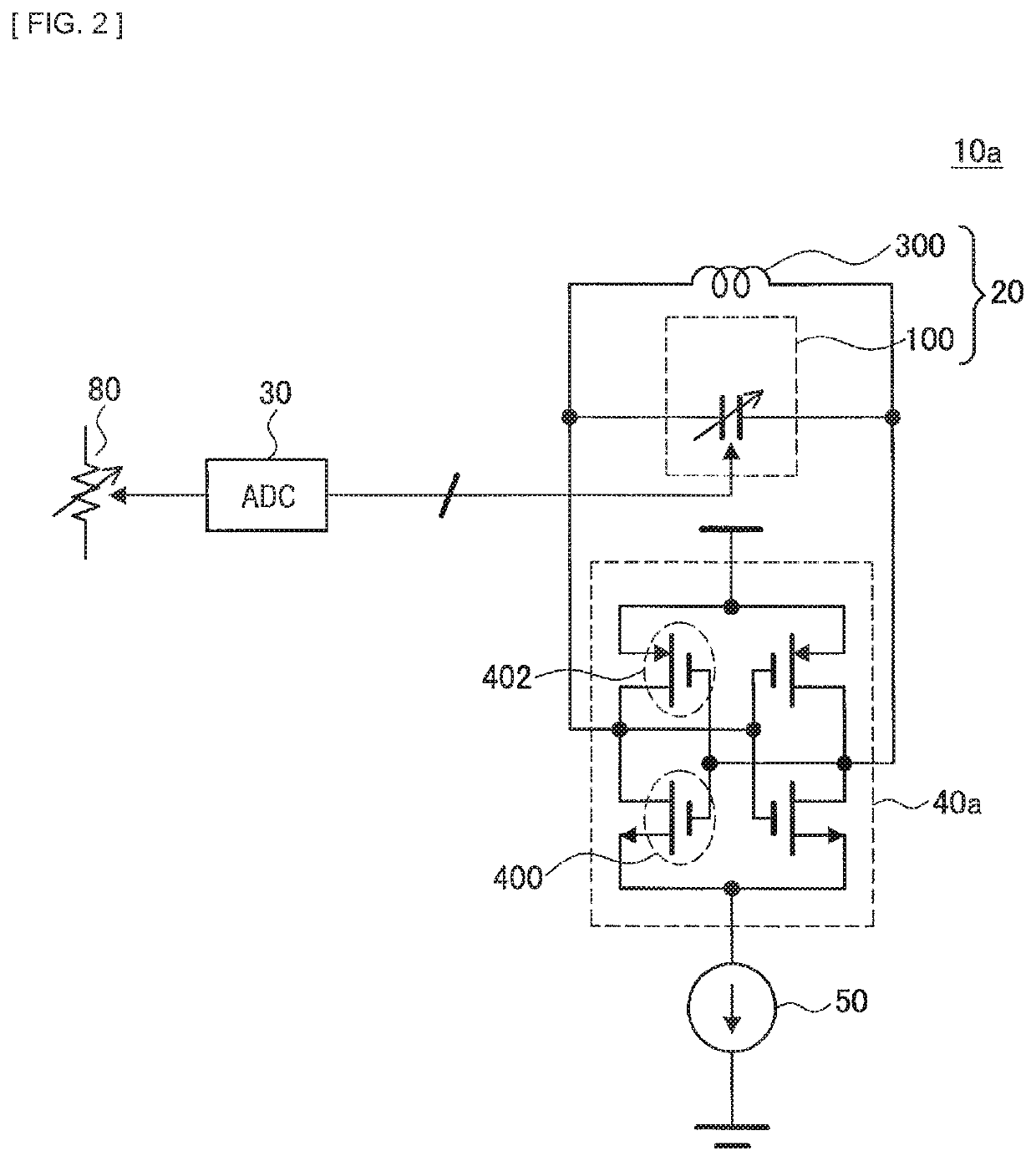Semiconductor device and wireless communication apparatus
a wireless communication and semiconductor technology, applied in the direction of pulse automatic control, oscillation generator, resonance circuit tuning, etc., can solve the problems of increasing and achieve the effect of maintaining manual operability and suppressing manufacturing cost and power consumption
- Summary
- Abstract
- Description
- Claims
- Application Information
AI Technical Summary
Benefits of technology
Problems solved by technology
Method used
Image
Examples
first embodiment
2. First Embodiment
[0072]First, a first embodiment of the present disclosure is described in detail with reference to FIGS. 1 and 2. FIG. 1 is a circuit diagram schematically illustrating a configuration of an oscillator 10 according to a first embodiment of the present disclosure, and FIG. 2 is a circuit diagram schematically illustrating a configuration of an oscillator 10a according to a modification example of the present embodiment.
[0073]As illustrated in FIG. 1, the oscillator 10 according to the present embodiment includes an LC oscillator (oscillation circuit) 20 including a capacity bank (capacitor) 100 and the inductor 300, an AD converter (Analog Digital Converter) (conversion circuit) (that is referred to as “ADC” in the diagram) 30, a negative resistance circuit 40, and a constant current source 50. The capacity bank (capacitor) 100 includes a plurality of capacitors (small capacitors) 102 (see FIG. 3). The oscillator 10 is an oscillator that oscillates an oscillation s...
second embodiment
3. Second Embodiment
[0083]As described above, in the above-described first embodiment of the present disclosure, appropriately selecting the capacity values of the respective capacitors 102 included in the capacity bank 100 and the number of capacitors 102 included in the capacity bank 100 makes it possible to generate an oscillation signal whose oscillation frequency linearly and continuously varies with respect to an inputted digital signal. In the first embodiment, however, the frequency of an oscillation signal is varied by discretely switching the total capacity value of the capacity bank 100 with a digital signal. In fact, the oscillator 10 thus has to switch the total capacity value of the capacity bank 100 within a minute variation range to generate an oscillation signal whose oscillation frequency linearly and continuously varies with respect to a digital signal as illustrated in FIG. 4.
[0084]In a semiconductor manufacturing process, however, the minimum capacity value or c...
embodiment 1
3.2 Present Embodiment 1
[0092]Accordingly, the method of controlling the frequency of the oscillator 10 is proposed in the second embodiment of the present disclosure. The method of controlling the frequency of the oscillator 10 makes it possible to generate an oscillation signal whose oscillation frequency linearly and continuously varies with respect to a digital signal within a minute variation range even if the manufacturable minimum capacity value is limited by the semiconductor manufacturing process to be used. The following describes the present embodiment with reference to FIGS. 5 to 9. Each of FIGS. 5 to 7 is an explanatory diagram for describing a method of controlling a frequency according to a second embodiment of the present disclosure. In addition, FIG. 8 is an explanatory diagram describing an example of variations in a capacity value in the method of controlling the frequency according to the present embodiment. FIG. 9 is an explanatory diagram describing an example ...
PUM
 Login to View More
Login to View More Abstract
Description
Claims
Application Information
 Login to View More
Login to View More - R&D
- Intellectual Property
- Life Sciences
- Materials
- Tech Scout
- Unparalleled Data Quality
- Higher Quality Content
- 60% Fewer Hallucinations
Browse by: Latest US Patents, China's latest patents, Technical Efficacy Thesaurus, Application Domain, Technology Topic, Popular Technical Reports.
© 2025 PatSnap. All rights reserved.Legal|Privacy policy|Modern Slavery Act Transparency Statement|Sitemap|About US| Contact US: help@patsnap.com



